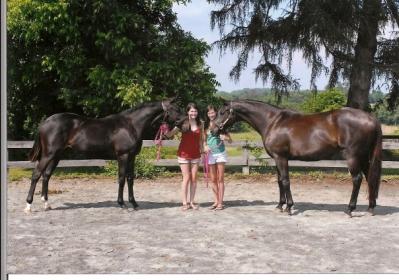I’m one who is open to the idea of using racing TB stallions for sport. HOWEVER, I want to know darn well what the stallion produces…looking at his page isn’t enough, I want to see lots of his offspring, and evaluate them for sport suitability. Realistically, you’re not going to be able to see dozens of them already under saddle and competing in your chosen sport discipline. But, if the sire is prolific enough, you can see a fair number of them on the farm, at the sales, and at the track. If you see enough individuals, you can learn what the stallion produces-- general type, conformational tendencies, faults, and movement.
The good thing about many TB sires is they put a lot of horses on the ground…go to the Keeneland sales and you’ll see many representatives of the same sires; you can learn what each stallion tends to throw (which may, or may not be seen in the pedigree!). If your goal is to breed a TB mare, this is very useful-- you’re seeing what the TB stallion produces with TB mares just like yours! (Instead of a WB stallion who may only be bred to “selective” TB sport mares to produce outstanding sport prospects, you’re looking at a TB stallion who’s bred to a general racing population of TB mares, not selected for sport…if that TB stallion can produce sporty progeny from typical TB mares, I consider that a plus!)
David Copperfield has about 80 horses on the ground; look at 20 or more of them and determine if you like what he produces. Does he give them good qualities? Or do they all look nothing alike, and take more after their dams? He bred about 20 horses a year 2004, 2005, 2006, and 2007; since then just a handful. I know a couple sons of Halo that make decent sport horses, but pedigree alone is way too much a risk to breed, at any price.
Personally, I’d pass. While I’m not breeding a racehorse, it is discouraging to see that his best runners, now 6 years old, earned less than $100,000. He had 23 runners this year, only 6 winners, and is ranked #97 on the Midwest Sires List (that’s Indiana, Ohio, IL, Iowa, etc. Not Kentucky). That suggests that, while he probably got some pretty poor mares, he didn’t do much (if anything) to improve them; he likely doesn’t produce athletes, especially from average mares.
For the sake of comparison, look at Action This Day (#7 Midwest List). He also stands for $1000 (in Indiana), with 48 winners from 95 runners in 2012. His best horse in 2012 earned $105,000, but he has 10 lifetime earners of 100,000 or more. Yes, he’s been bred to a lot more mares than David Copperfield…but that shows that he is more desirable, and more foals on the ground means more for you to look at. Personally, I’ve noticed the Kris S/Roberto type is very heritable (BIG, long shoulders, cat-like walk, long strides, and Robertos can jump!). To me, he is better to investigate than David Copperfield. (Many stallions are…that’s just one example.)




